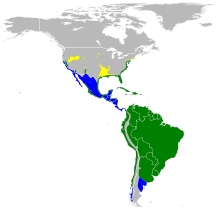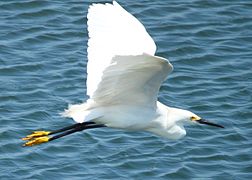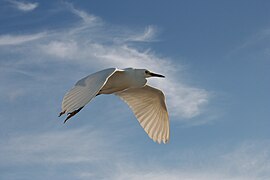Snowy egret
| Snowy egret | |
|---|---|

| |
| Scientific classification | |
| Domain: | Eukaryota |
| Kingdom: | Animalia |
| Phylum: | Chordata |
| Class: | Aves |
| Order: | Pelecaniformes |
| Family: | Ardeidae |
| Genus: | Egretta |
| Species: | E. thula
|
| Binomial name | |
| Egretta thula (Molina, 1782)
| |

| |
| Range of E. thula Breeding range Year-round range Wintering range
| |
| Synonyms | |

The snowy egret (Egretta thula) is a small white heron. The genus name comes from Provençal French for the little egret, aigrette, which is a diminutive of aigron, 'heron'. The species name thula is the Araucano term for the black-necked swan, applied to this species in error by Chilean naturalist Juan Ignacio Molina in 1782.[3]
The snowy egret is the American counterpart to the very similar Old World little egret, which has become established in the
Description
Adult snowy egrets are entirely white apart from the yellow lores between the long black bill and the eye, black legs, and bright yellow feet. The nape and neck bear long, shaggy plumes known as aigrettes.[6] Immature snowy egrets have duller, greenish legs.
Measurements:[7]
- Length: 22.1–26.0 in (56–66 cm)
- Weight: 13.1 oz (370 g)
- Wingspan: 39.4 inches (100 cm)
Distribution and habitat
The snowy egret is native to North, Central and South America. It is present all year round in South America, ranging as far south as Chile and Argentina. It also occurs throughout the year in the West Indies, Florida and coastal regions of North and Central America. Elsewhere, in the southern part of the United States, it is migratory, breeding in California, Nevada, Utah, Colorado, Arizona, New Mexico, Texas, Louisiana and Mississippi. It is found in wetlands of many types; marshes, riverbanks, lakesides, pools, salt marshes and estuaries. It is not found at high altitudes nor generally on the coast.[6] The snowy egret has occurred as a vagrant in Europe, in Iceland, Scotland and the Azores.[8] It has also been recorded in South Africa.[9]
Diet
The birds eat fish, crustaceans (such as crabs, shrimp and crayfish),[10] insects, small reptiles (such as lizards and snakes),[11] snails, frogs, toads[12] and worms (especially earthworms and other annelids).[13] They stalk prey in shallow water, often running or shuffling their feet, flushing prey into view by swaying their heads, flicking their wings or vibrating their bills. They may also hover, or "dip-fish" by flying with their feet just above the water surface. Snowy egrets may also stand still and wait to ambush prey, or hunt for insects stirred up by domestic animals in open fields. They sometimes forage in mixed species groups.[5]
Breeding
Snowy egrets breed in mixed colonies, which may include
Fossil finds
Fossils of the snowy egret have been reported from the
Status
In the early twentieth century, the snowy egret was hunted extensively for their long breeding plumes that fashionable ladies wore on their hats. This trade was ended in 1910 in North America but continued for some time in Central and South America. Since then populations have recovered.[5] The bird has a very wide range and the total population is large. No particular threats have been recognised and the population trend seems to be upwards, so the International Union for Conservation of Nature has assessed its conservation status as being of "least concern".[1]
Gallery
-
Head shot
-
Plumage displayed
-
Full breeding plumage
-
With chicks
-
Tayrona national park, Colombia
-
In flight
-
In flight
-
On the hunt, Daytona Beach, Florida, United States
-
Ponce Inlet Beach, Florida, United States.
-
A snowy egret and its hatchlings in St. Augustine, FL.
-
Snowy egret chicks in St. Augustine, FL
-
Snowy egret hunting in Queens, New York
-
Snowy Egret walking along water's edge while looking for food
References
- ^ . Retrieved 19 November 2021.
- ^ a b c Egretta thula at Fossilworks.org
- ^ Jobling, 2010, p.143, 385
- S2CID 155475716.
- ^ a b c d "Snowy Egret: Life History". All About Birds. TheCornellLab. Retrieved 29 March 2019.
- ^ S2CID 216257447. Retrieved 28 November 2019.
- ^ "Snowy Egret Identification, All About Birds, Cornell Lab of Ornithology". allaboutbirds.org. Retrieved 2020-09-26.
- ^ "Twitchers flock to see UK's first snowy egret". The Scotsman. Retrieved 25 December 2018.
- ^ Melanie Gosling (12 June 2015). "Rare bird draws watchers to Cape Town". Independent Online (originally in the Cape Times). Retrieved 31 August 2021.
- ^ "Egretta thula (Snowy egret)".
- ^ "Egretta thula (Snowy egret)".
- ^ "Egretta thula (Snowy egret)".
- ^ "Egretta thula (Snowy egret)".
- ^ Talara tar seeps at Fossilworks.org
- ^ Bradenton at Fossilworks.org
- ^ Haile XIB at Fossilworks.org
- ^ Ligon, 1966
Bibliography
- Jobling, James A (2010). The Helm Dictionary of Scientific Bird Names. London: Christopher Helm. pp. 143, 385. Retrieved 11 Dec 2019. ISBN 978-1-4081-2501-4
- Ligon, J.D (1965). "A Pleistocene avifauna from Haile, Florida" (PDF). Bulletin of the Florida State Museum, Biological Sciences. 10: 127–158. Retrieved 11 Dec 2019.
Further reading
- Stiles and Skutch, A guide to the birds of Costa Rica ISBN 0-8014-9600-4
- National Geographic, Field Guide to the Birds of North America ISBN 0-7922-6877-6
External links
- Snowy Egret – Cornell Lab of Ornithology
- Snowy egret Egretta thula - USGS Patuxent Bird Identification InfoCenter
- "Snowy egret media". Internet Bird Collection.
- Snowy egret photo gallery at VIREO (Drexel University)
- Snowy egret species account at Neotropical Birds (Cornell Lab of Ornithology)














